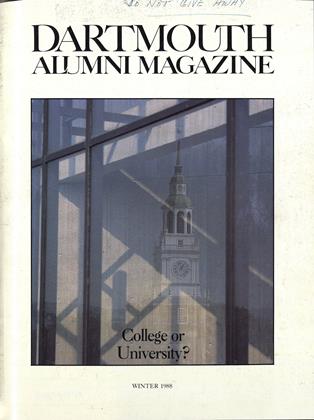The Man Who Invented the Ant Farm (Not to Mention the Ant Coal Mine)
December 1988 Lee MichaelidesVITA
"Go to the ant, thou sluggard," says the Bible (Proverbs 6:6). "Consider her ways, and be wise." In 1931 Frank Austin '95, a retired Thayer School electrical engineering professor, found himself broke; the stock market crash had wiped out his savings. So he went to the ant, considered her ways, and made a killing.
Austin's life was turned around when a young boy asked him if it were possible to see the inner workings of an ant hill. "People watch goldfish," the old professor said to himself. "So why shouldn't they be interested in watching ants?" He soon emerged from his Hanover workshop with a simple eight-byten frame supporting sandwiched panes of glass. And thus was born one of America's most popular pre-television recreations for children: ant husbandry.
Austin's invention became a huge success. At the peak of production in the mid-thirties, 400 ant houses a day were shipped out by the professor and his five assistants. Local children helped round up 3.6 million ants a year for a fee of four dollars a quart. The local railway office added a second employee to process the steady stream of insect Utopias.
With fortune came fame. The New York Times dubbed Hanover the "center of the new ant industry," and 5,000 people visited the workshop on South Park Street. The New Yorker, New York Herald Tribune and Forbes all profiled Austin, who became the star of a newsreel and appeared with Edgar Guest on the old NBC Blue network.
Austin used the publicity to pioneer the art of the spinoff. The original Austin Ant House, which sold for $3.50, eventually spawned a product line that included the Antville Fire House, the Antville Coal Mine, the Ant Arctic Polar Expedition, and an entire town called Ant Boro. Top-ofthe-line Ant Palaces sold for $50. Then there were spinoffs of the spinoffs. Ant Boro begat a radio series and the radio series begat a line of children's books. Austin also cranked out cricket schools and houses, butterfly rearing kits, and observational bee houses.
Not all of Austin's marketing efforts were successful. He misread the growth potential for ant farms in the health-care industry. Nor did a special plexiglass model designed for mental patients sell very well.
Ant farm fever eventually cooled, and Austin relocated to Orlando, Florida, where he operated a roadside museum until he died in 1964. But he remained a visionary. At the outbreak of World War Two he devised plans for a bomb-proof airplane factory inside Mt. Washington.
Clearly, Austin had considered the ant's ways and become wise: the drawings for the factory show a remarkable resemblance to the Antville Coal Mine.
Lee Michaelides, who is managing editor of this magazine, had an ant farm when he was ten.
 View Full Issue
View Full Issue
More From This Issue
-
 Cover Story
Cover StoryIs "The College" a College?
December 1988 By James O. Freedman -
 Feature
FeatureThe Compleat Engineer
December 1988 By Samuel C. Florman '46 -
 Feature
FeatureIs Vietnam Still Claiming Some of Us?
December 1988 By Karen Endicott -
 Article
ArticleCUTTING BONE
December 1988 -
 Article
ArticleBEYOND INTUITION
December 1988 By J. Laurie Snell -
 Class Notes
Class Notes1984
December 1988 By Eric Grubman
Lee Michaelides
-
 Article
ArticleDavid O. Hooke '84: Chubber's Boswell
NOVEMBER 1986 By Lee Michaelides -
 Article
ArticleStan Brakhage '55: "The Picasso of Cinema"
MAY • 1987 By Lee Michaelides -
 Feature
FeatureBad Things You Learned in Gym
OCTOBER • 1987 By Lee Michaelides -
 Feature
FeatureAre Conservatives Being Silenced?
NOVEMBER • 1987 By Lee Michaelides -
 Article
Article"A LIFETIME OF EXPERIENCE"
MAY 1990 By Lee Michaelides -
 Article
ArticleWhat’s New
Jan/Feb 2011 By Lee Michaelides
Features
-
 Feature
FeatureThe Reunion Week
July 1960 -
 Cover Story
Cover StoryHOW TO RAISE HAPPY KIDS
Jan/Feb 2009 By CHRISTINE CARTER '94 -
 Cover Story
Cover StoryHOW TO HOOK VIEWERS WITH AN ADDICTIVE SOAP OPERA STORYLINE
Jan/Feb 2009 By JEAN PASSANANTE '75 -
 COVER STORY
COVER STORYNature Worship
MAY | JUNE 2019 By jim collins ’84 -
 Feature
FeatureNomss de Blitz
OCTOBER 1998 By NOEL PERRIN -
 Cover Story
Cover StoryRobinson's Undoing
MARCH 1995 By Pam Kneisel '76

